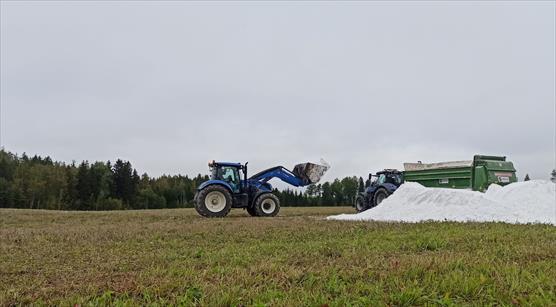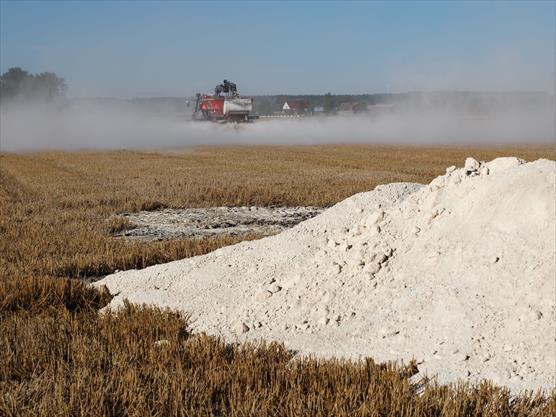Press release 2021-12-08 at 9:38

By treating fields with gypsum, erosion and the discharge of phosphorus and carbon from fields can be reduced significantly. © Photo: Iida Vartila
Press release of SYKE, LUKE, Turun AMK and ProAgria
Soil improving agents may quickly and effectively reduce the water pollution from agricultural land. Gypsum, pulp mill fibre, and structural lime have been studied comprehensively, and based on the results, a practical guide has been compiled, from which farmers can learn more about the use of these soil improving agents.
Amending parcels with soil improving agents affects the aggregate structure of the soils, resulting in decreased phosphorus losses and, thus, the eutrophication impact of farming. In addition to benefits for waterbodies, the parcels may better withstand different weather conditions. The field will dry more quickly in the spring and withstand drought better in the summer. Soil improving agents should be selected separately for each parcel.
Soil improving agents have been studied comprehensively, the studies have in 2019–2021 received funding from the Ministry of the Environment’s Water Protection Programme. The research results have now been compiled in a practical guide, from which farmers can select the most suitable soil improving agent for each parcel.
Soil improving agents support climate-smart arable farming. “However, soil improvement agents alone cannot permanently reduce non-point source loading. Instead, sustainable farming is based on a good soil structure, fertility, and water management in arable land,” says Juha Kääriä from the structural lime project.
Pulp mill fibres make microbial activities more effective
Pulp mill fibres are pulp and paper industry’s by-products that have been treated either by means of composting or lime stabilisation. Fibres are spread on fields using dry manure application equipment, and they are mixed in soil after spreading. The effectiveness of fibres is based on microbiology, because microbes consume the carbon contained by fibres. When decomposing fibres, microbes secrete slime that, with mycelia formed in the soil, improve the durability of soil aggregates. As a result, erosion and associated phosphorus losses decrease.
In rainfall simulations conducted by the Natural Resources Institute Finland (Luke), erosion and phosphorus losses halved during the summer following the application of fibres. The effectiveness of fibres was visible throughout the five-year research period. Similar results were also achieved in a field in Espoo, where the impact of fibres on the quality of drainage water was monitored. Currently, the effectiveness of fibres is also being studied in two catchment areas in Tuusula. Half of all the fields in one of the two catchment areas were treated with fibres in the autumn of 2021, while the other catchment area acts as an untreated control. The aim of the tests is to monitor catchment-scale effectiveness of pulp mill fibre amendment as a water protection measure.
Gypsum reduces the discharge of phosphorus and carbon from clay soils
By treating fields with gypsum, erosion and the discharge of phosphorus and carbon from fields can be reduced significantly. Gypsum is the most effective in terms of water protection in clay soils, where it causes soil particles to form into larger microaggregates. Gypsum also intensifies the binding of phosphorus to the surface of soil particles, while keeping phosphorus available for crops.
Furthermore, gypsum reduces the discharge of erosion-associated phosphorus and dissolved phosphorus. In addition to its impact on water protection, some farmers who have used gypsum have also found improvements in the soil structure. Gypsum is also a good sulphur fertilizer. The effectiveness of gypsum is direct and visible to the naked eye: discharged water is clearer. At its best, gypsum remains effective for more than five years.
amendments has been used extensively in the KIPSI (GYPSUM) project in the Archipelago Sea’s catchment area. In the project, gypsum has been spread over a total of 16,900 hectares in cooperation with farmers (in 2021–2021). The project will continue in 2022–2023, and the goal is to spread gypsum over a total field area of 50,000–65,000 hectares in the Archipelago Sea’s catchment area. In addition, the expansion of the project to all Finnish coastal areas is being prepared. Previously, gypsum has been spread over an area of nearly 6,000 hectares in Finland.
Structural lime produces the most benefits in clay soils with a poor soil structure
Structural lime is a soil improvement agent for clay soils, in which arable land is treated with a liming agent containing not only calcium carbonate, but also slaked lime or quicklime. Structural liming differs from regular liming in that in addition to raising the soil pH level, it aims to have a quick and long-term impact on the aggregate structure of clay soils. Structural liming may improve the soil workability, and parcels treated with structural lime may dry more quickly in the spring and be less prone to erosion than untreated parcels. In addition, structural lime improves the seedbed as a result of the better crumb structure of clay soils, and the more even crumb distribution in the surface layer reduces evaporation, which produces benefits especially during dry periods.
Structural liming has been studied in laboratory and in extensive field tests, in which structural lime has been spread over an area of approximately 200 hectares. According to research results, a tonne of active substance (slaked or quick lime) per hectare is already effective in reducing water pollution. Structural lime produces the most benefits in clay soils in which the crumb structure is poor, and electrical conductivity is low.

Structural lime must be spread and prepared in a dry, warm and windless weather. A long-term impact can only be achieved if active structural lime is spread and prepared immediately after it has been transported to the field. © Photo: Juha Kääriä
More information:
Structural lime
Juha Kääriä, Turku University of Applied Sciences, +358 50 598 5776, juha.kaaria@turkuamk.fi
Gypsum
Petri Ekholm, Finnish Environment Institute, +358 29 525 1102 petri.ekholm@syke.fi
Soil improvement fibres
Kimmo Rasa, Luke, +358 29 532 6468, kimmo.rasa@luke.fi
Link to material and additional information (in Finnish)
The guide on the use of soil improvement agents has been prepared in cooperation between specialists from the Finnish Environment Institute, the Natural Resources Institute Finland, the Water Protection Association of the River Vantaa and Helsinki Region, the Keski-Uusimaa environment institute, Turku University of Applied Sciences, the Pyhäjärvi Institute, the Sugar Beet Research Centre, and ProAgria Western Finland.
The use of soil improvement agents has been studied and advanced as part of the Ministry of Environment’s Water Protection Programme (2019–2023), which is a significant investment in water protection. Its goal is to achieve a good status in the Baltic Sea and inland waters. The programme’s measures aim to reduce nutrient pollution from agriculture and forestry in watercourses, remove oil from shipwrecks, remediate watercourses, and reduce harmful substances in urban waters.
Funded projects:
Fibre sludge as a water protection method in agriculture (FIBRE) (in Finnish)
Structural lime as a water protection method in agriculture (STRUCTURAL LIME) (in Finnish)